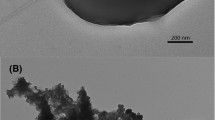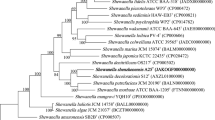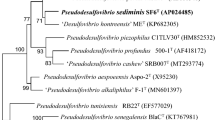Abstract
Studies on the microorganisms living in hydrocarbon-contaminated sediments in San Diego Bay, California led to the isolation of a novel Fe(III)-reducing microorganism. This organism, designated strain SDBY1, was an obligately anaerobic, non-motile, non-flagellated, gram-negative rod. Strain SDBY1 conserves energy to support growth from the oxidation of acetate, lactate, succinate, fumarate, laurate, palmitate, or stearate. H2 was also oxidized with the reduction of Fe(III), but growth with H2 as the sole electron donor was not observed. In addition to various forms of soluble and insoluble Fe(III), strain SDBY1 also coupled growth to the reduction of fumarate, Mn(IV), or S0. Air-oxidizedminus dithionite-reduced difference spectra exhibited peaks at 552.8, 523.6, and 422.8 nm, indicative ofc-type cytochrome(s). Strain SDBY1 shares physiological characteristics with organisms in the generaGeobacter, Pelobacter, andDesulfuromonas. Detailed analysis of the 16S rRNA sequence indicated that strain SDBY1 should be placed in the genusDesulfuromonas. The new species nameDesulfuromonas palmitatis is proposed.D. palmitatis is only the second marine organism found (afterD. acetoxidans) to oxidize multicarbon organic compounds completely to carbon dioxide with Fe(III) as an electron acceptor and provides the first pure culture model for the oxidation of long-chain fatty acids coupled to Fe(III) reduction.
Similar content being viewed by others
References
Aller RC (1990) Bioturbation and managanese cycling in hemipelagic sediments. Philos Trans R Soc Lond A 331:51–68
Aller RC, Macklin JE, Cox RTJ (1986) Diagenesis of Fe and S in Amazon inner shelf muds: apparent dominance of Fe reduction and implications for the genesis of ironstones. Cont Shelf Res 6:263–289
Baedecker MJ, Cozzarelli IM, Siegel DI, Bennett PC, Eganhouse RP (1993) Crude oil in a shallow sand and gravel aquifer. 3. Biogeochemical reactions and mass balance modeling in anoxic ground water. Appl Geochem 8:569–586
Balch WE, Fox GE, Magrum LJ, Woese CR, Wolfe RS (1979) Methanogens: reevaluation of a unique biological group. Microbiol Rev 43:260–296
Blumentals II, Itoh M, Olson GJ, Kelly RM (1990) Role of polysulfides in reduction of elemental sulfur by the hyperthermophilic archaebacteriumPyrococcus furiosus. Appl Environ Microbiol 56:1255–1262
Caccavo F Jr, Blakemore RP, Lovley DR (1992) A hydrogen-oxidizing, Fe(III)-reducing microorganism from the Great Bay Estuary, New Hampshire. Appl Environ Microbiol 58:3211–3216
Caccavo F, Lonergan DJ, Lovley DR, Davis M, Stolz JF, McInerney MJ (1994)Geobacter sulfurreducens sp. nov., a hydrogen-and acetate-oxidizing dissimilatory metal-reducing microorganism. Appl Environ Microbiol 60:3752–3759
Canfield DE (1989) Reactive iron in marine sediments. Geochim Cosmochim Acta 53:619–632
Canfield DE, Thamdrup B, Hansen JW (1993a) The anaerobic degradation of organic matter in Danish coastal sediments: Fe reduction, Mn reduction, and sulfate reduction, Geochim Cosmochim Acta 57:3867–3883
Canfield DE, Jørgensen BB, Fossing H, Glud R, Gundersen J, Ramsing NB, Thamdrup B, Hansen JW, Nielsen LP, Hall POJ (1993b) Pathways of organic carbon oxidation in three continental margin sediments. Marine Geol 113:27–40
Christensen D (1984) Determination of substrates oxidized by sulfate reduction in intact cores of marine sediments. Limnol Oceanogr 29:189–192
Cline JD (1969) Spectrophotometric determination of hydrogen sulfide in natural waters. Limnol Oceanogr 14:454–458
Coleman ML, Hedrick DB, Lovley DR, White DC, Pye K (1993) Reduction of Fe(III) in sediments by sulphate-reducing bacteria. Nature 361:436–438
De Soete G (1983) A least-squares algorithm for fitting additive trees to proximity data. Psychometrika 48:621–626
Eden PE, Schmidt TM, Blakemore RP, Pace NR (1991) Phylogenetic analysis ofAquaspirillum magnetotacticum using polymerase chain reaction-amplified 16S rRNA-specific DNA. Int J Syst Bacteriol 41:324–325
Finster K, Bak F, Pfennig N (1994)Desulfuromonas acetexigens sp. nov., a dissimilatory sulfur-reducing eubacterium from anoxic freshwater sediments. Arch Microbiol 161:328–332
Hines ME, Bazylinski DA, Tugel JB, Lyons WB (1991) Anaerobic microbial biogeochemistry in sediments from two basins in the Gulf of Maine: evidence for iron and manganese reduction. Estur Coast Shelf Sci 32:313–324
Hobbie JE, Daley RJ, Jasper S (1977) Use of Nucleopore filters for counting bacteria by fluorescence microscopy. Appl Environ Microbiol 33:1225–1228
Hungate RE (1969) A roll tube method for cultivation of strict anaerobes. Methods Microbiol 3B:117–132
Jukes TH, Cantor CR (1969). Evolution of protein molecules. In: Munro HN (ed) Mammalian protein metabolism. Academic Press, New York London, pp 21–132
Lane DJ, Field KG, Olsen GJ, Pace NR (1988) Reverse transcriptase sequencing of ribosomal RNA for phylogenetic analysis. Methods Enzymol 167:138–144
Larson N, Olsen GJ, Maidak BL, McCaughey MJ, Overbeek R, Macke T, Marsh TL, Woese CR (1993) The ribosomal database project. Nucleic Acids Res 21:3201–3023
Lonergan DJ, Lovley DR (1991). Microbial oxidation of natural and anthropogenic aromatic compounds coupled to Fe(III) reduction. In: Baker RA (ed) Organic substances and sediments in water. Lewis, Chelsea, Mich., pp. 327–338
Lovley DR (1991) Dissimilatory Fe(III) and Mn(IV) reduction. Microbiol Rev 55:259–287
Lovley DR (1993) Dissimilatory metal reduction. Annu Rev Microbiol 47:263–290
Lovley DR (1994) Microbial reduction of iron, manganese, and other metals. Adv Agron 54:175–231
Lovley DR, Lonergan DJ (1990) Anaerobic oxidation of toluene, phenol, and p-cresol by the dissimilatory iron-reducing organism, GS-15. Appl Environ Microbiol 56:1858–1864
Lovley DR, Phillips EJP (1986a) Organic matter mineralization with reduction of ferric iron in anaerobic sediments. Appl Environ Microbiol 51:683–689
Lovley DR, Phillips EJP (1986b) Availability of ferric iron for microbial reduction in bottom sediments of the freshwater tidal Potomac River. Appl Environ Microbiol 52:751–757
Lovley DR, Phillips EJP (1988) Novel mode of microbial energy metabolism: organic carbon oxidation coupled to dissimilatory reduction of iron or manganese. Appl Environ Microbiol 54:1472–1480
Lovley DR, Phillips EJP (1989) Requirement for a microbial consortium to completely oxidize glucose in Fe(III)-reducing sediments. Appl Environ Microbiol 55:3234–3236
Lovley DR, Phillips EJP, Lonergan DJ (1995b) Fe(III) and S0 reduction byPelobacter carbinolicus. Appl Environ Microbiol 61:2132–2138
Lovley DR, Stolz JF, Nord GL, Phillips EJP (1987) Anaerobic production of magnetite by a dissimilatory iron-reducing microorganism. Nature 330:252–254
Lovley DR, Baedecker MJ, Lonergan DJ, Cozzarelli IM, Phillips EJP, Siegel DI (1989) Oxidation of aromatic contaminants coupled to microbial iron reduction. Nature 339:297–299
Lovley DR, Coates JD, Woodward JC, Phillips EJP (1995a) Benzene oxidation coupled to sulfate reduction. Appl Environ Microbiol 61:953–958
Lovley DR, Giovannoni SJ, White DC, Champine JE, Phillips EJP, Gorby YA, Goodwin S (1993a)Geobacter metallireducens gen. nov. sp. nov., a microorganism capable of coupling the complete oxidation of organic compounds to the reduction of iron and other metals. Arch Microbiol 159:336–344
Lovley DR, Roden EE, Phillips EJP, Woodward JC (1993b) Enzymatic iron and uranium reduction by sulfate-reducing bacteria. Marine Geol 113:41–53
Lovley DR, Woodward JC, Chapelle FH (1994) Stimulated anoxic biodegradation of aromatic hydrocarbons using Fe(III) ligands. Nature 370:128–131
Lyngkilde J, Christensen TH (1992) Fate of organic contaminants in the redox zones of a landfill leachate pollution plume (Vejen, Denmark). J Contamin Hydrol 10:291–307
Mackie RI, White BA, Bryant MP (1991) Lipid metabolism in anaerobic ecosystems. Crit Rev Microbiol 17:449–479
Miller TL, Wolin MJ (1974) A serum bottle modification of the Hungate technique for cultivating obligate anaerobes. Appl Microbiol 27:985–987
Pfennig N, Biebl H (1976)Desulfuromonas acetoxidans gen. nov. and sp. nov., a new anaerobic, sulfur-reducing, acetate-oxidizing bacterium. Arch Microbiol 110:3–12
Rabus R, Nordhaus R, Ludwig W, Widdel F (1993) Complete oxidation of toluene under strictly anoxic conditions by a new sulfate-reducing bacterium. Appl Environ Microbiol 59: 1444–1451
Roden EE, Lovley DR (1993) Dissimilatory Fe(III) reduction by the marine microorganism,Desulfuromonas acetoxidans. Appl Environ Microbiol 59:734–742
Schink B (1992) The genusPelobacter. In: Balows A, Trüper HG, Dworkin, M., Harder W, Schleifer K.H. (eds) The prokaryotes. Springer, New York Berlin Heidelberg, pp 3393–3399
Sørensen J (1982) Reduction of ferric iron in anaerobic, marine sediment and interaction with reduction of nitrate and sulfate. Appl Environ Microbiol 43:319–324
Sørensen J, Jørgensen BB (1987) Early diagenesis in sediments from Danish coastal waters: microbial activity and Mn-Fe-S geochemistry. Geochim Cosmochim Acta 51:1583–1590
Sørensen J, Christensen D, Jorgensen BB (1981) Volatile fatty acids and hydrogen as substrates for sulfate-reducing bacteria in anaerobic marine sediment. Appl Environ Microbiol 42:5–11
Weisburg WG, Barns SM, Pelletier DA, Lane DJ (1991) 16S ribosomal DNA amplification for phylogenetic study. J Bacteriol 173:697–703
Widdel F (1988) Microbiology and ecology of sulfate- and sulfur-reducing bacteria. In: Zehnder AJB (ed) Biology of anaerobic microorganisms. Wiley, New York, pp 469–585
Author information
Authors and Affiliations
Rights and permissions
About this article
Cite this article
Coates, J.D., Lonergan, D.J., Philips, E.J.P. et al. Desulfuromonas palmitatis sp. nov., a marine dissimilatory Fe(III) reducer that can oxidize long-chain fatty acids. Arch. Microbiol. 164, 406–413 (1995). https://doi.org/10.1007/BF02529738
Received:
Accepted:
Issue Date:
DOI: https://doi.org/10.1007/BF02529738




